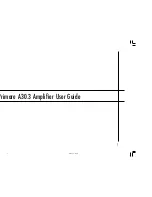
13
Steps to Resolve
1. Turn off the amplifier before connecting or
disconnecting any cabling.
2. Check the speaker wire polarity at the amplifier and
at the speakers. For example, if the red and black
wires are reversed at the amplifier, with the black
wire connected to the right channel positive and the
red wire connected to the right channel negative,
reverse them.
3. Turn the power on the amplifier back on and play
the speakers. Do the speakers have better bass and
do voices seem to emanate somewhere between
the speakers? If yes, then you have solved the polarity
problem.
4. If the wiring looks correct at the amplifier, then the
polarity reversal may be at the speaker location. If
the speakers are inaccessible and reversing their wire
polarity is impractical, then reversing the polarity at
the amplifier may be the best option.
5. If the wire/speaker polarity is not the issue, ensure
the line-level input signals are full-range and not
being filtered at the source. If necessary, connect a
local full-range source to the left and right inputs on
the suspect amplifier pair, such as the audio output
of a mobile audio device.
6. With a second, known working source in place, do
the speakers now have full-range sound? If yes,
then the preamp supplying the audio signal to
the suspect channels in the amplifier should be
investigated.
7. If the speakers still do not have much bass output,
connect a different, properly working pair of test
speakers to this amplifier pair in question. Do the
local test speakers have good bass? If so, then the
speakers in that zone will need to be uninstalled and
tested separately; replace one or both speakers as
necessary.
LOW AUDIO VOLUME
Potential Reasons
•
The source providing the audio signal into the
amplifier has inadequate output voltage.
•
The volume control on the source is turned down.
of these four connections are reversed at either the
amplifier or at the speakers, then one speaker will
be moving outward while the other speaker will be
moving inward. This will cause bass cancellation and
voices to sound ‘hollow’ or emanating from the sides
of the speakers instead of between them.
•
The speakers are supplied with a high-passed signal
rather than a full-range signal. A high-passed signal
will have significantly reduced bass output below a
given frequency.
•
One or both of the woofers in the speakers have an
issue.
•
The volume controls on the back panel of the
amplifier are turned down.
Steps to Resolve
1. Determine the voltage output rating of the source
feeding the amplifier. Some source components
such as music-servers, CD players and tuners have
sufficient output voltage for use with a preamplifier,
but insufficient for use with a power amplifier. If the
source is rated for the same output voltage as the
input sensitivity rating of the amplifier (or greater),
then this is not the cause of the low volume. If the
output voltage of the source is below the input
sensitivity rating, then a preamp will need to inserted
between the two.
2. Check the volume control setting on the source
(if applicable). Some sources such as a DVD player
have fixed line-level outputs that cannot be varied.
Increase the volume output on the source if its
variable.
3. Check the setting of the volume controls on the back
panel of the amplifier. Turn them up as necessary,
but below the point they cause distortion in the
speakers. The primary reason the amplifier has
volume controls is to protect the speakers from
being overdriven and damaged.
TROUBLESHOOTING: DISTORTION
Potential Reasons
•
The source providing audio input to the amplifier has
distortion and the amplifier is reproducing it.
•
The source is providing too high of an output signal
and it’s overdriving the input stage on the amp.
•
The RCA cable connecting the source to the amplifier
is compromised.
•
The speaker wire has been shorted somewhere
between the speaker and the amplifier.
•
The speakers have been overdriven and damaged.
•
The 16-50 or 8-50 has an internal fault.
Steps to Resolve
1. Turn off the amplifier before connecting or
disconnecting any cabling.
2. Check the Speaker Block Connectors to ensure wire
strands from adjacent connections are not touching
and shorting out. Ensure all the wires are correctly
and securely inserted into the Speaker Block
Connector and are not loose. A complete short will
normally trigger the protection circuitry and mute
the shorted channels. However, the amplifier can
drive a ‘partial’ short or an excessively low impedance
to a certain level, but with attendant distortion. Make
sure the speaker impedance is 4 Ohms and above for
each channel.
3. Substitute another, known working RCA cable
between the source and the inputs.



































